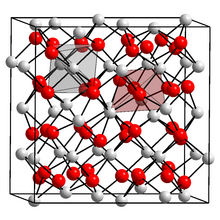Scandium oxide
 | |
| Names | |
|---|---|
| IUPAC name
Scandium(III) oxide
| |
| Other names
Scandia, scandium sesquioxide
| |
| Identifiers | |
3D model (
JSmol ) |
|
ECHA InfoCard
|
100.031.844 |
PubChem CID
|
|
| UNII | |
CompTox Dashboard (EPA)
|
|
| |
SMILES
| |
| Properties | |
| Sc2O3 | |
| Molar mass | 137.910 g/mol |
| Appearance | White powder |
| Density | 3.86 g/cm3 |
| Melting point | 2,485 °C (4,505 °F; 2,758 K) |
| insoluble in water | |
| Solubility | soluble in hot acids (reacts) |
| Structure[1] | |
| Bixbyite | |
| Ia3 (No. 206) | |
a = 985 pm
| |
| Hazards | |
| NFPA 704 (fire diamond) | |
| Related compounds | |
Other anions
|
Scandium(III) sulfide |
Other cations
|
Yttrium(III) oxide Lutetium(III) oxide |
Except where otherwise noted, data are given for materials in their standard state (at 25 °C [77 °F], 100 kPa).
| |
Scandium(III) oxide or scandia is a
Structure and physical properties
Scandium(III) oxide adopts a cubic crystal structure (point group: tetrahedral (Th), space group: Ia3) containing 6-coordinate metal centres.[2] Powder diffraction analysis shows Sc−O bond distances of 2.159–2.071 Å.[1]
Scandium oxide is an insulator with a band gap of 6.0 eV.[3]
Production
Scandium oxide is the primary form of refined scandium produced by the mining industry. Scandium-rich ores, such as thortveitite (Sc,Y)2(Si2O7) and kolbeckite ScPO4·2H2O are rare, however trace amounts of scandium are present in many other minerals. Scandium oxide is therefore predominantly produced as a by-product from the extraction of other elements.
Reactions
Scandium oxide is the primary form of refined scandium produced by the mining industry, making it the start point for all scandium chemistry.
Scandium oxide reacts with most acids upon heating, to produce the expected
Likewise, it is converted into hydrated
Metallic scandium is produced industrially by the
Scandium oxide forms scandate salts with alkalis, unlike its higher homologues
Natural occurrence
Natural scandia, although impure, occurs as mineral kangite.[6]
References
- ^ doi:10.1139/v68-236.
- ISBN 0-19-855370-6
- .
- .
- ISBN 0-08-043748-6, Vol. 3, p. 99 ["Refluxing scandium oxide with triflic acid leads to the isolation of hydrated scandium triflate"]
- ^ Mindat, http://www.mindat.org/min-42879.html

